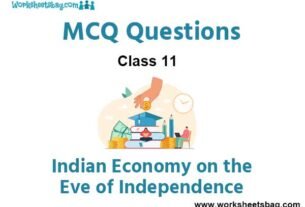Please refer to MCQ Questions Chapter 5 Human Capital Formation In India Class 11 Economics with answers provided below. These multiple-choice questions have been developed based on the latest NCERT book for class 11 Economics issued for the current academic year. We have provided MCQ Questions for Class 11 Economics for all chapters on our website. Students should learn the objective based questions for Chapter 5 Human Capital Formation In India in Class 11 Economics provided below to get more marks in exams.
Chapter 5 Human Capital Formation In India MCQ Questions
Please refer to the following Chapter 5 Human Capital Formation In India MCQ Questions Class 11 Economics with solutions for all important topics in the chapter.
MCQ Questions Answers for Chapter 5 Human Capital Formation In India Class 11 Economics
Question. Which programme started in 1994
a) District Primary Education Programme
b) Kasturba Gandhi Balika Vidyalaya
c) Sarva Siksha Abhiyan
d) Mid-day meal
Answer
A
Question. Human capital is investment that brings
a) Quantitative improvement in labour
b) Qualitative improvement in labour
c) Both
d) None
Answer
B
Question. Which cost is involved in Migration?
a) Transportation cost
b) Higher Living cost in different place
c) Both a and b
d) None of these
Answer
C
Question. Which of the following is not an indicator of education level?
a) Years of schooling
b) Life expectancy
c) Teacher-pupil ratio
d) Enrollment rate
Answer
B
Question. Problems in Human Capital Formation is
a) Low academic standards
b) Brain Drain
c) Rising population
d) All of these
Answer
D
Question. ICMR regulate the
a) Banking sector
b) Education sector
c) Health Sector
d) Tourism Sector
Answer
C
Question. _______ is a regulating authority of the education sector in India.
a) ICMR
b) Sarva Siksha abhiyan
c) Kendra Vidhalaya
d) University grants commission
Answer
D
Question. ________ is based on the idea that education and health are integral to human beings.
a) Human capital
b) Human development
c) Human capital formation
d) None of the above
Answer
B
Question. In how many stages of education are there in India
a) 1
b) 2
c) 3.0
d) 4
Answer
C
Question. Which of the following are indicators of HDI are
a) Longevity
b) Educational attainment
c) Standard of living
d) All of these
Answer
D
Question. Role of human capital formation in economic growth
a) Raises life expectancy
b) Improves quality of life
c) Innovative skills
d) All of the
Answer
D
Question. Which of the following is not the feature of India Vision 2020 Report
a) 90% of literacy in India
b) If we double the investments in education it will increase the country’s GDP per capita by four times
c) 100 % enrolment of all children of age group 6-14 years
d) Importance of technical education
Answer
A
Question. _____ on health makes human more efficient and productive.
a) Expenditure
b) Investment
c) Both a and b
d) None of these
Answer
C
Question. People of which age group are treated as productive labour force
a) 60-70
b) 15-60
c) 15-35
d) 0-6
Answer
B
Question. ________builds efficiency of actual capital
a) Human capital
b) Physical capital
c) Both a) and (b)
d) None of the above
Answer
C
Question. Machines and buildings are
a) Human capital
b) Natural capital
c) Physical capital
d) None of these
Answer
D
Question. According to India Vision report 2020, _____ percent literate India is paramount importance to realise the vision for the country in 2020
a) 100.0
b) 80
c) 75
d) 60
Answer
A
Question. In 1950-51 India literacy rate was
a) 0.16
b) 0.12
c) 0.15
d) 0.18
Answer
D
Question. Under which five year plan , importance was given to human capital formation
a) Seventh
b) Sixth
c) Fifth
d) Fourth
Answer
A
Question. A person becomes a human resource when he/she
a) Belongs to particular age group
b) Is willing to work
c) Is able to work
d) All of the these
Answer
D
Question. The norm AICTE stands for:
a) All India Council for Technology Education
b) All India Council for Technical Education
c) All India Commission for Technology Education
d) All India Commission for Technical Education
Answer
B
Question. Educational attainment is measured by the two-third weighted average of the _____and one-third weight ______
a) adult literacy rate, mean years of schooling
b) adult literacy rate, mean years of secondary schooling
c) literacy rate, mean years of primary schooling
d) adult gross literacy rate, mean years of schooling
Answer
A
Question. By 2005 , 1% of the world population in the age group 15-49 was affected by
a) Cough
b) Diarrhoea
c) HIV/AIDS
d) Cholera
Answer
C
Question. 4 Mentioned are the names of the states. Which among these states has the least literacy rate?
a) Mizoram
b) Bihar
c) Kerala
d) None of these
Answer
B
Question. Which of the following institutes comes under the health sector?
a) NCERT
b) UGC
c) AICTE
d) ICMR
Answer
D
Question. What was the share of education in total government expenditure in 2014?
a) 7.92 percent
b) 15.7 percent
c) 0.64 percent
d) 3.31 percent
Answer
B
Question. Which of the following is not the role of on-the-job training?
a) Eradicates inequality
b) Encourages innovation
c) Promotes modern methods
d) Enhances productivity
Answer
D
Question. How much educational cess has been imposed by the government on all Union taxes?
a) 1 %
b) 2%
c) 4%
d) 5%
Answer
B
Question. What percent of GDP was invested in education in the year 1952?
a) 7.92 percent
b) 11.7 percent
c) 0.64 percent
d) 3.31 percent
Answer
C
Question. To provide the educational facilities to the children of transferable central government employees _____ were established
a) Navodaya Vidayalas
b) Kendriya Vidyalayas
c) Both
d) None
Answer
B
Question. A major problem faced by the human capital formation in India is
a) Rising population
b) Developed technology
c) Rising prices
d) Devaluation of currency
Answer
A
Question. Stocks/shares of the companies are known as:
a) Human Capital
b) Physical Capital
c) Financial Capital
d) None
Answer
C



